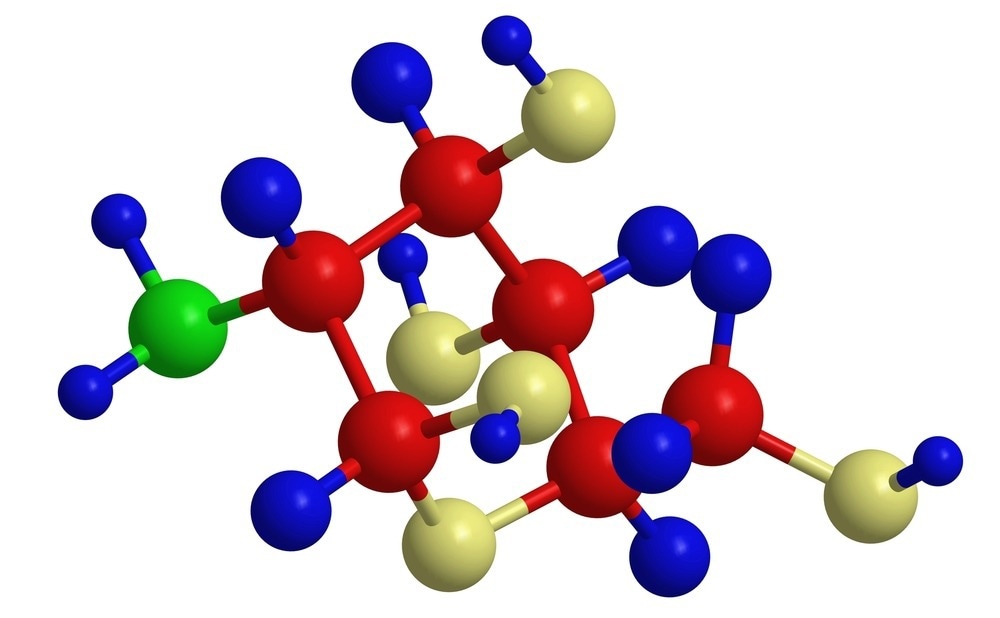 By Surbhi JainReviewed by Susha Cheriyedath, M.Sc.Jul 7 2022
By Surbhi JainReviewed by Susha Cheriyedath, M.Sc.Jul 7 2022In an article recently published in the journal International Journal of Biological Macromolecules, researchers discussed the development of hydrogels of chitosan and hyaluronic acid that can be photo-crosslinked and are self-repairable.

Study: Photocrosslinkable and self-healable hydrogels of chitosan and hyaluronic acid. Image Credit: Raimundo79/Shuttertsock.com
Background
In situ gelling hydrogels for biosensing, drug administration, and tissue engineering applications have been developed using the intriguing method of polymerizing monomers or polymers by ultraviolet (UV) and visible light. Overall, free-radical-initiated chain polymerization is the type of photopolymerization reaction that is most frequently utilized in the biomedical industry.
Chitosan stands out above the competition due to its promising physicochemical and cell adhesion qualities, despite the fact that there are many promising polymers for the production of photocrosslinkable hydrogels. To create hydrogels that can be photocrosslinked in situ, chitosan has been chemically conjugated with photopolymerizable groups employing a variety of chemical processes.
In this situation, methacrylated chitosan and hyaluronic acid could be used to create hydrogels that are biocompatible, photocrosslinkable, biodegradable, in situ forming, and self-healing. Hyaluronic acid and chitosan have not been directly combined in several studies, and there is no data on the electrostatic interactions between photocured methacrylated chitosan hydrogels and hyaluronic acid. Methacrylated chitosan, which is distinct from hyaluronic acid, has been used in recent years as printable hydrogel ink, either alone or in combination with other polysaccharides, usually gelatin.
About the Study
In this study, the authors discussed the development of methacrylated chitosan (CHIMe) and hyaluronic acid-based photocrosslinkable hydrogels that displayed tuneable physicochemical properties according to their composition. An ideal phenyl-2,4,6-trimethylbenzoylphosphinate (LAP) initiator feed was discovered through research on photopolymerized CHIMe's conversion, mechanical, gelation time, and rheological properties.
The team created chitosan hydrogels that were photocurable and self-healing, and also investigated the potential for self-healing properties in these kinds of doubly crosslinked networks. Fourier transform infrared (FTIR) spectroscopy and photo-differential scanning calorimetry (DSC) were used to thoroughly examine the methacrylation-based alteration of chitosan and the subsequent photocuring process with and without hyaluronic acid.
The mechanical stability, morphology, rheological characteristics, swelling, and degradation of the produced CHIMe/HA hydrogels were evaluated. These characteristics were significantly influenced by the hydrogel composition.
The researchers demonstrated the mechanical, rheological, and biocompatibility characteristics of the prepared hydrogels. Their potential for functioning as scaffolds, drug or cell transporters, and value in biological applications like tissue engineering and wound treatment were illustrated.
Observations
The chitosan-only hydrogels containing 0.05% LAP disintegrated completely in 5 days. Hyaluronidase degradation occurred more quickly in 50:50 CHIMe: HA gels at 0.05% LAP than in 70:30 CHIMe: HA gels. When a hydrogel sample of 50:50 CHIMe with 0.05% of LAP was subjected to a strain above its deformation limit, the typical behavior of a gel G' > G" was flipped to that of a quasi fluid G" > G'. The deformability of the healed 50:50 CHIMe: HA 0.05% LAP hydrogel was slightly reduced from 80 to 60% of breakage strain regardless of the number of cut-recovery cycles, and in the case of hydrogels with 0.1% LAP, the deformability oscillated around that of the original hydrogel.
In spite of cycles of self-healing processes, the prepared photocrosslinkable hydrogels showed the ability to promote doubly crosslinked hydrogels with similar Young Moduli and to tailor swelling with 25–70 swelling factor, 1x10-4 to 2x10-2 MPa mechanical strength, and rheological properties as a function of polysaccharides relative content.
There was ample proof that CHIMe/HA solutions were quickly photopolymerized to produce biocompatible hydrogels with greater than 80% cell viability, biodegradability up to 20–24 days in hydrolytic media, suitable durability, and self-healing properties appropriate for cutting-edge biomedical and tissue engineering applications.
Conclusions
In conclusion, this study elucidated the development of photocrosslinkable hydrogels based on hyaluronic acid and methacrylated chitosan. The prepared hydrogels had specific physico-chemical properties. Hydrogels based on CHIMe/HA demonstrated that a reduced photocrosslinkable chitosan level promotes hydrophilicity, supporting hydrogel swelling. High CHIMe contents, however, improved mechanical and rheological properties by enhancing covalent crosslinking. On the other hand, all the prepared hydrogels exhibited 100% disintegration during the first 20 to 24 days in a hydrolytic media and five to ten days in an enzymatic medium with hyaluronidase and lysozyme, despite their varying swelling capacities.
In addition to being biocompatible, all hydrogels showed outstanding and quick self-recovery of their shape following damage, independent of their composition.
Disclaimer: The views expressed here are those of the author expressed in their private capacity and do not necessarily represent the views of AZoM.com Limited T/A AZoNetwork the owner and operator of this website. This disclaimer forms part of the Terms and conditions of use of this website.
Source:
Maiz-Fernández, S., Pérez-Álvarez, L., Silván, U., et al. Photocrosslinkable and self-healable hydrogels of chitosan and hyaluronic acid. International Journal of Biological Macromolecules (2022). https://www.sciencedirect.com/science/article/pii/S0141813022014283